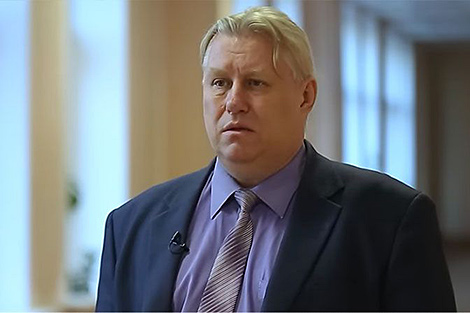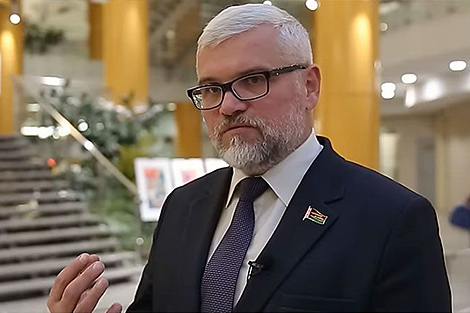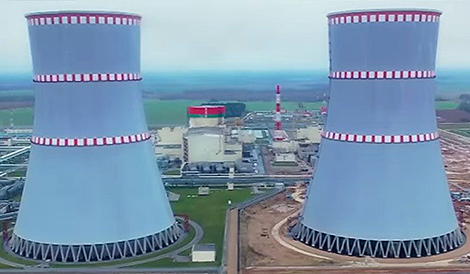News & Events in Belarus
Peace is paramount. Reasons why Lukashenko reintroduced October Revolution Day as public holiday

There are many good traditions in Belarus. We inherited many of them from the Soviet past. For example, voluntary clean-up days and the student construction brigade movement. Perhaps someone considers them a relic of the past. But Belarusians have never abandoned their heritage. Aleksandr Lukashenko believes that it is impossible to cross out one's history. It is important to adopt the best things from the past and bring them to the present. In previous episodes we talked about Belarus’ clean-up days and student construction brigades. Now we will tell you why Aleksandr Lukashenko decided to revive October Revolution Day and why the head of state calls 7 November a holiday of peace and true human rights. What lesson, according to the Belarusian president, should we learn from the events of a hundred years back, and what slogans of the October Revolution underlie the current policy of the Belarusian state?
When did Belarus start celebrating October Revolution Day?
Let's take a dive into history. In the capital of the BSSR, the October Revolution day was first celebrated in 1920. In 1918, the city was under the rule of Germany, and in 1919 - under Poland. Only in the summer of 1920, the Soviet power was finally established in the city. In Minsk, on the third anniversary of the October Revolution, the holiday lasted for two days. The city held voluntary clean-up days, a military parade, and a rally on Freedom Square. New clubs were opened in the run-up to the day. Since then, the day has become a holiday for Minsk residents.

The Day of the Great October Revolution, along with May Day, was the main holiday in the entire Soviet Union. It was considered the final point of various workplace competitions and deadline pressures. Labor feats were also timed to coincide with another anniversary of the revolution. This tradition translated into the inauguration of important facilities. One of the first was the restored building of the Minsk railway station, which was burned down back in 1920. It was solemnly reopened six years later. By the 10th anniversary of the revolution, a bakery and a bristle factory were launched. In 1933, those were the Government House and the monument to Lenin in front of it, and the Minsk airport.
The essence of the holiday is perfectly described in an article in the Sovietskaya Belorussia newspaper. On 25 May 1949, the newspaper wrote: "On the site of the former club of food industry workers, construction is in full swing. The new building of the Pobeda cinema house is already taking shape. The builders are set to fulfill their commitment to finish the new cinema house in Minsk by the 32nd anniversary of the October Revolution."

Why does Belarus still celebrate 7 November?
After the collapse of the Soviet Union, the holiday practically disappeared from the public holiday calendars of the post-Soviet countries. However, Belarusian President Aleksandr Lukashenko urged to keep celebrating the anniversary of the October Revolution and to keep the tradition of launching new important facilities by 7 November. Thus, in 1997 the president took part in a solemn ceremony to commission the Partizanskaya and Avtozavodskaya metro stations. And in the spring of 1998, October Revolution Day became a public holiday.
“I am on board with all the ideas proclaimed by the revolutionaries. There was not a single bad slogan. The revolution won under these slogans. Many of them are aligned with the current policy of our country. When we mark October Revolution Day, we celebrate, first of all, these ideas and slogans. We came under heavy criticism because of that. Our critics argued that the revolution brought trouble, killed people. But killings started later. We are talking about ideas. We condemn the carnage and the abandoning of the ideas that lay at the heart of the revolution. But this happened later. The killings do not negate what happened in 1917; they do not nullify all the good ideas that Vladimir Lenin and his team proclaimed during their revolutionary drive,” Aleksandr Lukashenko told journalists after commissioning a new section of the First Line of the Minsk metro in 2012.
What lessons should be learned from the October Revolution?
Aleksandr Lukashenko always advised to be careful about the past, because many events are very politicized. Bad things should not be hushed up, but good things should not be forgotten either, the head of state emphasized.
Scientists and politicians still struggle to assess the October Revolution. Some interpret it as a catastrophe that led to the Civil War. Others view it as an important step towards progress. The president of Belarus calls 7 November a celebration of peace and true human rights. You remember what was happening in the Russian Empire and around it in the lead-up to the October Revolution. The First World War was raging, people were dying. The economy was in tatters. And the main lesson that must be learned from 1917 is that peace should not be taken for granted, Aleksandr Lukashenko said.
“War leads to grave consequences. Back then it led to the collapse of the country, we lost part of our country, we know that. A huge swathe of territory stretching up to Minsk was forfeited as a result of the war in line with peace treaties. We lost Western Ukraine, Western Belarus. Therefore, this day is an obvious holiday for everyone as it underscores the importance of peace and an opportunity to live a normal life,” Aleksandr Lukashenko said as he met with workers who built the bridge in Zhitkovichi District, as well as local residents in November 2018.
Could the 1917 revolution be averted?
Associate Professor of the Department of History of Southern and Western Slavs of the Belarusian State University, Candidate of Historical Sciences Sergei Aleksandrovich emphasized that the October Revolution was a historical objectivity, as the Russian Empire was in a deep economic, political, and social crisis following the First World War and other problems.
“1917 showed that chaos can continue indefinitely and the country must be brought out of such a state. It is necessary to give people stability, hope, and progress. There were various revolutionary parties: Bolsheviks, Mensheviks, SRs, anarchists. The Bolsheviks stood out for their program, which was more understandable to the people for its strict discipline. They were able to take power into their hands and hold it,” the historian recalled.

The war destroyed the main human right - the right to life. Those who remained in the rear were starving. There was no access to medical care or education. What human rights can we talk about in a war-ravaged country where the economy came to a standstill, people were jobless, when the strong preyed on the weak? Therefore, according to the Belarusian president, the October Revolution is also a celebration of true human rights.
"When the Soviet Union collapsed, everything Soviet was condemned. Our history was condemned. This is wrong. This is our history, we cannot change it. I did not renounce my communist past. But I became president; times were changing. So I proposed: let's not destroy monuments, rename streets, let's continue some 7 November traditions (after all, we celebrated the day). This idea took root in the country. Starting from local authorities and ending with the president, we continue this tradition to launch new facilities ahead of this day. Who will be against this? No one. Thus we continue to celebrate this holiday," the head of state said.
How the October Revolution relates to modern Belarus
According to Sergei Aleksandrovich, many people mistakenly reduce the revolution only to the events of 25-26 October (7-8 November on the Gregorian calendar), but in fact it is a huge layer of transformations.

“Russia came out of the war to deal with its internal problems. These were land issues: it was an agricultural country, and it was necessary to give land to those who cultivated it. It was a question of the rights of nations and nationalities. The country was multinational, and the rights of different nations were not defined. The roots of our statehood come from there. For us this holiday is a kind of tribute to those traditions, those events that led to the independence of our country,” the candidate of historical sciences said.
One more point. Almost everything that Belarus has today has its roots in the Soviet era. After the Great Patriotic War, the Belarusians managed to restore their country from ruins. We owe much to the Soviet Union. Why should not we appreciate and respect the heritage of our ancestors?
Vyacheslav Danilovich, a member of the House of Representatives, Doctor of Historical Sciences, believes that the main lesson of the October Revolution is that the authorities should observe the balance of interests of various social groups and strata of society.

“The roots of the welfare state grow from there. The roots of the modern Belarusian state also lie in the revolutionary events of 1917. Therefore, 7 November, from my point of view, is absolutely justified to be a public holiday. We bring a constructive, positive agenda to this holiday. To mark the date, we inaugurate various social, cultural facilities, metro stations and so on. We emphasize the creative aspect of what we are doing,” Vyacheslav Danilovich said.
What facilities are opened in Belarus to mark 7 November?
What about the ribbon-cuts on this day? Some 15 stations of the Minsk metro were inaugurated in different years to mark October Revolution Day. We can also name numerous social facilities and healthcare institutions opened in Minsk and regional centers. But the most unusual event was probably the inauguration of the Belarusian Nuclear Power Plant.

7 November is, perhaps, the most fruitful holiday. Instead of slogans, banners and promises there are real deeds and fruits of labor. We have listed only a few facilities that were opened with the participation of the head of state. Imagine how many red ribbons are cut all over Belarus on this day.
Dozens of them are cut every year to inaugurate pipelines and roads, clinics and medical centers, kindergartens, rental apartments, industrial enterprises and agricultural complexes. Sports facilities (for example, Chizhovka Arena and the Gymnastics Palace in Mogilev), bridges over the Pripyat, Sozh and Dnieper, gas supply networks in Zhitkovichi, Petrykov, Glusk and other Polesie regions are just a few among the projects implemented over the years.
“Many consider the revolution a distant past. After all, more than a hundred years have passed. This is our history. It cannot be erased; it cannot be rewritten. Whoever tried to throw a stone at the past by rewriting it got that stone back in the present. We have kept the holiday intact. Time passes, and we needed to add a new meaning to the holiday. By 7 November, the party and the government always oriented the people towards great construction projects. When construction projects were completed, cut-ribbon ceremonies were held across the Soviet Union. We kept this good tradition, so that we could take stock of the progress made in agriculture, industry and social sector by the end of the year, by 7 November,” Aleksandr Lukashenko said.
One can trace the priorities of the state policy in Belarus by the facilities inaugurated ahead of 7 November. These are, first of all, the creation of comfortable living conditions for people and new jobs. Simply put, a person has always been the main priority for the state.







 print version
print version make home page
make home page add to bookmarks
add to bookmarks

